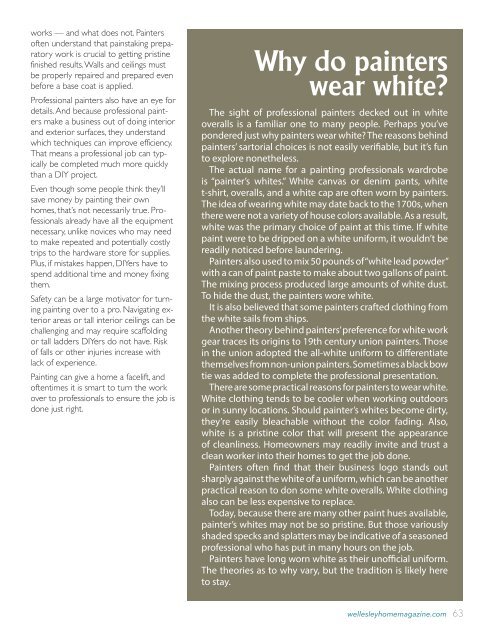Wellesley Home Magazine 2022-23
Wellesley Home Magazine 2022-23
Wellesley Home Magazine 2022-23
Create successful ePaper yourself
Turn your PDF publications into a flip-book with our unique Google optimized e-Paper software.
works — and what does not. Painters<br />
often understand that painstaking preparatory<br />
work is crucial to getting pristine<br />
finished results. Walls and ceilings must<br />
be properly repaired and prepared even<br />
before a base coat is applied.<br />
Professional painters also have an eye for<br />
details. And because professional painters<br />
make a business out of doing interior<br />
and exterior surfaces, they understand<br />
which techniques can improve efficiency.<br />
That means a professional job can typically<br />
be completed much more quickly<br />
than a DIY project.<br />
Even though some people think they’ll<br />
save money by painting their own<br />
homes, that’s not necessarily true. Professionals<br />
already have all the equipment<br />
necessary, unlike novices who may need<br />
to make repeated and potentially costly<br />
trips to the hardware store for supplies.<br />
Plus, if mistakes happen, DIYers have to<br />
spend additional time and money fixing<br />
them.<br />
Safety can be a large motivator for turning<br />
painting over to a pro. Navigating exterior<br />
areas or tall interior ceilings can be<br />
challenging and may require scaffolding<br />
or tall ladders DIYers do not have. Risk<br />
of falls or other injuries increase with<br />
lack of experience.<br />
Painting can give a home a facelift, and<br />
oftentimes it is smart to turn the work<br />
over to professionals to ensure the job is<br />
done just right.<br />
Why do painters<br />
wear white?<br />
The sight of professional painters decked out in white<br />
overalls is a familiar one to many people. Perhaps you’ve<br />
pondered just why painters wear white? The reasons behind<br />
painters’ sartorial choices is not easily verifiable, but it’s fun<br />
to explore nonetheless.<br />
The actual name for a painting professionals wardrobe<br />
is “painter’s whites.” White canvas or denim pants, white<br />
t-shirt, overalls, and a white cap are often worn by painters.<br />
The idea of wearing white may date back to the 1700s, when<br />
there were not a variety of house colors available. As a result,<br />
white was the primary choice of paint at this time. If white<br />
paint were to be dripped on a white uniform, it wouldn’t be<br />
readily noticed before laundering.<br />
Painters also used to mix 50 pounds of “white lead powder”<br />
with a can of paint paste to make about two gallons of paint.<br />
The mixing process produced large amounts of white dust.<br />
To hide the dust, the painters wore white.<br />
It is also believed that some painters crafted clothing from<br />
the white sails from ships.<br />
Another theory behind painters’ preference for white work<br />
gear traces its origins to 19th century union painters. Those<br />
in the union adopted the all-white uniform to differentiate<br />
themselves from non-union painters. Sometimes a black bow<br />
tie was added to complete the professional presentation.<br />
There are some practical reasons for painters to wear white.<br />
White clothing tends to be cooler when working outdoors<br />
or in sunny locations. Should painter’s whites become dirty,<br />
they’re easily bleachable without the color fading. Also,<br />
white is a pristine color that will present the appearance<br />
of cleanliness. <strong>Home</strong>owners may readily invite and trust a<br />
clean worker into their homes to get the job done.<br />
Painters often find that their business logo stands out<br />
sharply against the white of a uniform, which can be another<br />
practical reason to don some white overalls. White clothing<br />
also can be less expensive to replace.<br />
Today, because there are many other paint hues available,<br />
painter’s whites may not be so pristine. But those variously<br />
shaded specks and splatters may be indicative of a seasoned<br />
professional who has put in many hours on the job.<br />
Painters have long worn white as their unofficial uniform.<br />
The theories as to why vary, but the tradition is likely here<br />
to stay.<br />
wellesleyhomemagazine.com 63

















